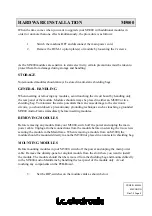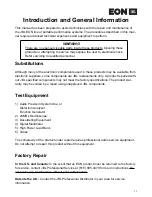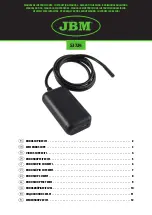
Page 41
472H Potato Harvester Owner Operator’s Manual
Rear Cross Belted Chains:
The rear cross belted chains is the first change of direction
for the potatoes in the harvester. The rear cross belted chain
maintains proper loading procedures, since a high percent-
age of bruising occurs at drops where flow direction changes.
Recommended chain speed to ground speed ratio for rear
cross belted chains should be about .5. Keep the rear cross
belted chain as full as possible without allowing spill-out or
roll-back under the secondary belted chain.
Rear cross belted chains should always have some type of
rubber covering. See section 6.4 on chain covering and de-
scriptions.
Bulk Boom Belted Chains:
The bulk boom belted chains change the potato flow direc-
tion for the last time on the harvester. Belted chains in the
bulk boom conveyor should always have a rubber covering.
The outer two sections of the bulk boom conveyor both hinge
with hydraulic cylinder controls. This allows the operator to
keep the conveyor angle as low as possible to prevent roll-
back and to lower the end of the boom as far as possible
into the truck box.
Keep belted chain speeds for the bulk boom conveyor slow
enough to keep the conveyor full but not slower than 1.1mph
(96 feet per minute). Make adjustments by changing sprocket
sizes or hydraulic flow.
3.21 GENERAL LOW DAMAGE POTATO HARVESTING (CONT’D)
3.21.2 BELTED CHAINS (CONT’D)
Primary Belted Chains:
The primary belted chain elevates the potatoes out of the
ground. The process of separating dirt and trash from pota-
toes begins on the primary belted chain. The primary belted
chain should eliminate at least 80% of the soil by the time
the potato reaches the secondary belted chain. The soil
carried up the primary belted chain will provide a slight cush-
ion for the potatoes. Changing either the belted chain speed
or the forward ground speed will change the amount of dirt
carried up the primary belted chain.
Use chain patterns in the primary belted chain to carry po-
tatoes with a minimal amount of roll-back. Do not use a one
up, one down chain pattern that pinches potatoes when con-
cerned about bruising.
Run the primary belted chain speed slightly faster than the
forward ground speed, usually at a ratio of 1.0 - 1.2 for sandy
soils and 1.3 - 1.5 for heavier soils. Operators may have to
adjust these speeds to keep the belted chains full, depend-
ing on harvesting and yield conditions. Adjust speeds by
changing the hexagonal bore sprockets on the primary drive,
on the primary drive, or varying engine RPM.
In heavier soil conditions, use shakers. Adjust shakers to
allow desired amount of shaking action.
Secondary Belted Chains:
The secondary belted chain provides additional soil separa-
tion and has a rubber covering to provide protection from
bruising. The secondary belted chain normally has a pat-
tern that includes down rods to prevent rollback and to carry
the potatoes up the steeper conveyor.
The primary belted chain will eliminate most of the soil by
the time the potatoes reach the secondary belted chain.
Therefore, run the secondary belted chain much slower than
the primary belted chain. Place the belted chain speed to
ground speed ratio for the secondary belted chain at about
.5; however, the secondary belted chain speed should never
run slower than 1.1 mph (96 feet per minute) to provide proper
loading onto the rear cross conveyor. The operator sets the
secondary belted chain speed to keep it as full as possible
without affecting delivery onto the rear cross belted chain.
Adjust speeds by changing the hexagonal bore sprockets
on the main drive.
Side Elevator Belted Chains:
The side elevator belted chains change the potato flow di-
rection from the rear cross unto the bulk boom. The side
elevator belted chains should always have a rubber cover-
ing.
Potato rollback can occur due to the side elevator’s incline.
To help prevent rollback, flights or pegged belted chains can
be used.
















































